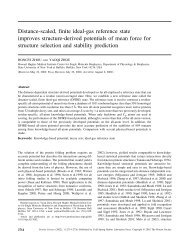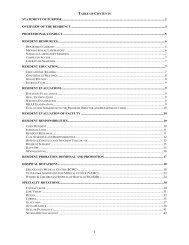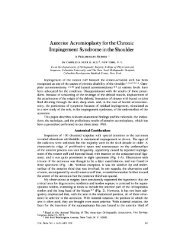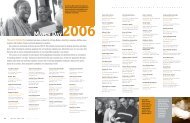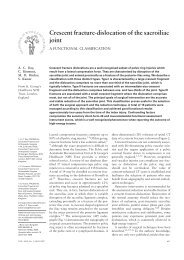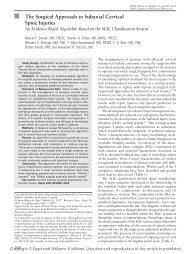Secondary Chondrosarcoma
Secondary Chondrosarcoma
Secondary Chondrosarcoma
Create successful ePaper yourself
Turn your PDF publications into a flip-book with our unique Google optimized e-Paper software.
is required for secondary chondrosarcomas<br />
to arise within the benign<br />
cartilaginous origin. This process is<br />
sometimes accompanied by chromosomal<br />
instability and aneuploidy, the<br />
severity of which may depend on the<br />
particular genes that are mutated.<br />
These have not been well characterized.<br />
Most secondary chondrosarcomas<br />
arise in osteochondromas; thus, it<br />
seems as though the model of tumorigenesis<br />
starting with mutation of<br />
EXT genes would apply to most of<br />
the tumors. However, this may not<br />
account for all secondary chondrosarcomas,<br />
and the genetic pathway<br />
may well be distinct in chondrosarcomas<br />
that arise in enchondromas.<br />
Ollier disease and Maffucci syndrome<br />
are characterized by multiple<br />
enchondromas dispersed through the<br />
skeleton. Maffucci syndrome is distinguished<br />
from Ollier disease by the<br />
presence of multiple soft-tissue hemangiomas,<br />
and it is less common<br />
than Ollier disease. Both diseases are<br />
known to give rise to secondary<br />
chondrosarcoma, but because of the<br />
rarity of the conditions, the rate at<br />
which malignant transformation occurs<br />
is not well-documented. Estimates<br />
range from 10% to 40% in<br />
patients with Ollier disease at longterm<br />
follow-up. 9,11,35 Some authors<br />
believe that patients with Maffucci<br />
syndrome may be at greater risk of<br />
developing malignancy; in one series,<br />
4 of 7 patients with Maffucci syndrome<br />
developed chondrosarcoma. 35<br />
However, reviews of published case<br />
reports have indicated estimates approximately<br />
15% to 20%. 12,36<br />
The genetics of Ollier disease and<br />
Maffucci syndrome differ from those<br />
of HME. Both diseases seem to arise<br />
sporadically without an obvious genetic<br />
inheritance pattern. It is believed<br />
that a combination of multiple<br />
genes may be involved, but those<br />
have not been identified. One report<br />
identified two cases of a mutation<br />
(one somatic, one germline) in the<br />
gene encoding the PTH/PTHrP type I<br />
receptor. 37 It was hypothesized that<br />
the mutation could delay the differentiation<br />
of proliferating chondrocytes<br />
by constitutively activating<br />
hedgehog signaling. However, this<br />
mutation was not found consistently<br />
in other tumors upon further study. 38<br />
Prevention, Treatment,<br />
and Outcome<br />
The risk of malignant transformation<br />
of benign cartilage tumors has not been<br />
well established, and estimates vary<br />
widely. For solitary osteochondromas,<br />
the risk is most likely 5-year<br />
follow-up. 5,7,13 Patients with solitary<br />
osteochondromas tend to have a better<br />
overall prognosis, with a 5-year<br />
mortality rate of 6.5%, compared<br />
with 19.6% for patients with HME. 7<br />
Metastasis may be more apt to occur<br />
in the rare high-grade secondary<br />
chondrosarcoma. 7<br />
October 2010, Vol 18, No 10 613




